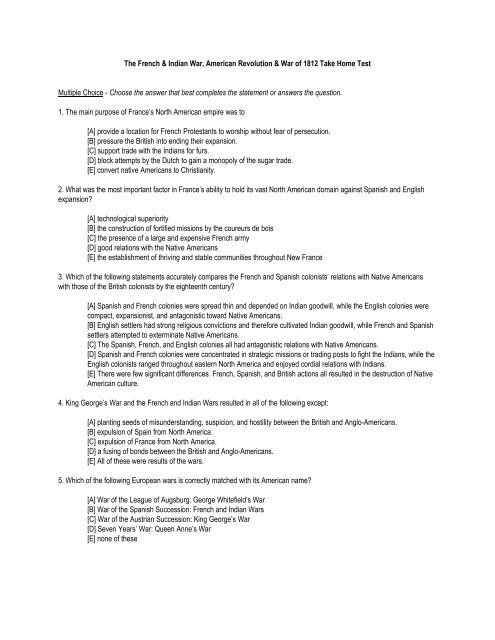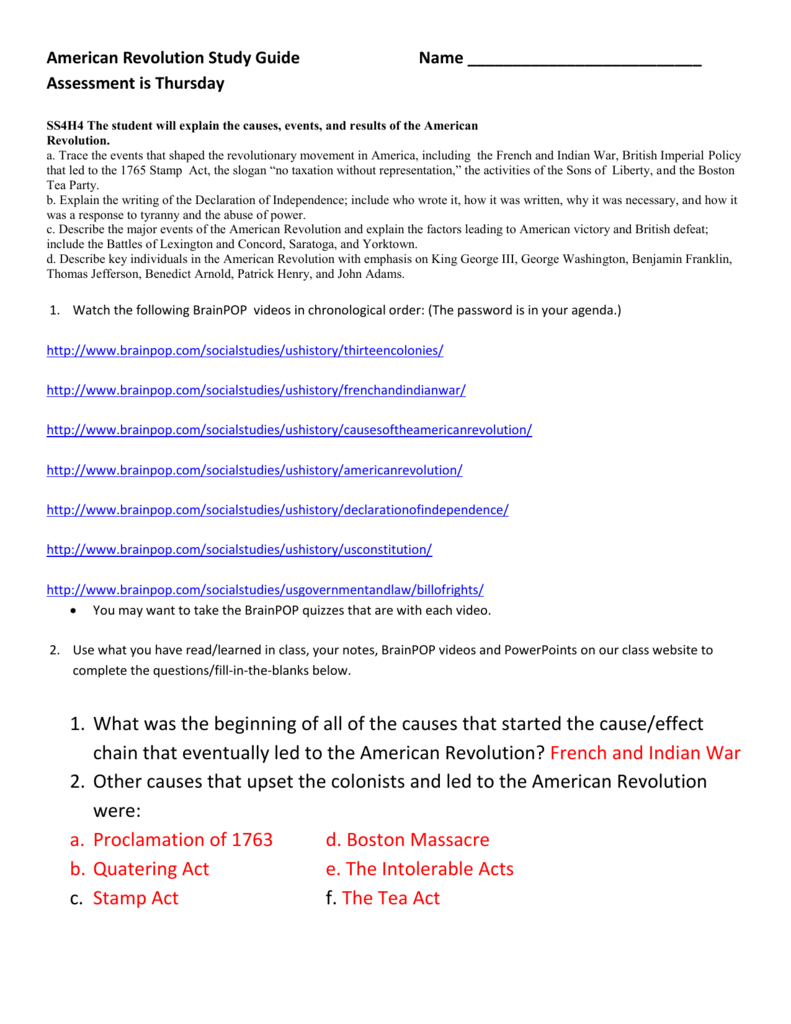2 Results Of The American Revolution
Religion and the American Revolution
The Causes, Events, and Results of the American Revolution Unit Name: The Causes, Events, and Results of the American Revolution Unit Created By: Megan McGuire Stage 1 – Desired Results Established Goals History SS4H4: The student will explain the causes, events, and results of the American Revolution. American Revolution. American Revolution The American Revolution is a war to reckon with and was actually a significant event in the history of American and basically, if there was no revolutionary war the United States of America may not have been in existence. The American Revolution brought an end to the two centuries of British rule for most of the North American colonies and brought the. The American Revolutionary War inflicted great financial costs on all of the combatants, including the United States, France, Spain and the Kingdom of Great Britain. France and Great Britain spent 1.3 billion livres and 250 million pounds, respectively. The United States spent $400 million in wages for its troops.
Christine Leigh Heyrman
Department of History, University of Delaware
©National Humanities Center
Teaching the American Revolution presents a prime opportunity to instruct your students in the ways that religion shaped the American past. Most people today think of the War for Independence as a purely secular event, a chapter in political, constitutional, military, and diplomatic history. They envision an initial resistance to the British empire triggered mainly by constitutional objections to taxation without representation; a colonial war of liberation won by a timely alliance with the French and the inspired strategies of Nathanael Greene and George Washington in the South; and, finally, republican governments at both the state and national levels being set in place by founding fathers whose most absorbing concerns were political rather than religious.
This 1762 cartoon depicts the angry
response of Boston Congregationalists to
the specter of an Anglican bishop being
appointed by the King. Note the blend of
civil and religious rebellion in the banner
(left): “No Lords, Spiritual or Temporal
in New England.” The note near the rat
reads “Shall they be obliged to maintain
Bishops that cannot maintain
themselves?” How does this statement
relate to the cry “No taxation without
representation”?That “take” on the American Revolution is not wrong, but it is incomplete. In fact, it’s only by understanding the religious situation of colonials that we can fully account for how many ordinary Americans were drawn into the resistance to Britain and then committed to the cause of rebellion and republicanism. And, indeed, that is the question that particularly intrigues many contemporary historians: What was the role played by religion in the emergence of mass support for the cause of colonial independence and military mobilization against the British?
A big topic, and the question is: How do you address it in the classroom? What follows are two practical suggestions—approaches that work with the college freshmen I teach and could easily be adapted to high school juniors and seniors.

The first is to get students thinking about possible connections between the First Great Awakening and the American Revolution. You can do that by encouraging them to consider the experiences of colonials in the decades just before the onset of the imperial crisis in the mid 1760s, which for many included being swept up in evangelical revivals, perhaps even being converted. In other words, the members of the revolutionary generation had faced, as individuals, important choices about their fundamental religious beliefs and loyalties, and that experience may have prepared them to make equally crucial and basic decisions about their political beliefs and loyalties. More important, no small number of those men and women who converted during the First Great Awakening had defied traditional authorities to uphold their new religious convictions. Some had criticized and ultimately rejected their former ministers or churches for not being sufficiently evangelical, while others had challenged the legitimacy of state-supported churches, which they deemed enemies to individual religious freedom. In short, this was a generation of people who had, during their youth, been schooled in the importance of self-determination and even rebellion against the existing hierarchies of deference and privilege.
The second approach—and my favorite—involves introducing students to Thomas Paine’s Common Sense. This celebrated (and admirably brief and accessible) treatise was the eighteenth-century equivalent of a runaway bestseller. Published in January of 1776, it became an overnight sensation—a pamphlet pored over by people in the privacy of their homes and read aloud in taverns and other public gathering places everywhere in British North America. In short, a wide range of colonials, literate as well as illiterate, felt the force of Paine’s arguments for breaking with Britain, and what he wrote persuaded enough undecided men and women to embolden the Continental Congress to endorse the Declaration of Independence by July of 1776.
Why did Common Sense succeed so brilliantly as a piece of political propaganda? Among other reasons, because it is a kind of secular sermon, an extraordinarily adroit mingling of religion and politics. Look at the opening paragraphs ('Time makes more converts than reason.') in which Paine casts the decision to support the cause of rebellion as a matter of feeling rather than thought, as a process akin to that of evangelical conversion. Review his assault on monarchy, which boils down to the proposition that all kings are blasphemous usurpers who claim a sovereign authority over other human beings that rightfully belongs only to God. Notice, too, how vehemently Paine insists that the Jews of the Old Testament rejected monarchical government—the obvious conclusion being that God’s new “chosen people” in America should follow that example. Consider his assertion that the colonies are an asylum of religious liberty, implying that Americans must pass from argument to arms to protect freedom of conscience for religious dissenters. And, finally, don’t miss how often the cadences of Common Sense echo and even reiterate the language of the Bible.

Ironically, Thomas Paine was anything but an orthodox Christian. Although bred to Quakerism in England during his youth, he had shed that religious influence years before writing Common Sense and later proudly proclaimed his deistical views in a pamphlet entitled The Age of Reason—which prompted pious Protestants, even as late as the twentieth century, to denounce him as a “dirty little atheist.” But even if Paine was less than sincere—indeed, entirely disingenuous—in invoking the evangelical sentiments that suffuse Common Sense, he had an intuitive grasp of religious appeals that would move his American audience to political action. In other words, while Common Sense is not a reliable guide to Paine’s private religious opinions, its enthusiastic reception in America tells us a great deal about the religious views of his audience.
For that reason alone (and there are many others besides), introducing your students to this stirring classic is one of the best moves you could make. If you’ve got a bright group, assign the whole pamphlet; if you’ve got fledglings, give them several snippets of Common Sense and spend half an hour opening up these bits of the text for them. Whatever you decide, be sure to read certain passages aloud—which is how many illiterate Americans encountered Paine’s words. He was—and remains—an irresistibly compelling spokesperson for the republican tradition, and Common Sense stands as the best example of how deeply politics and religion were intertwined for many men and women of the revolutionary generation.

American Revolution Pdf
Historians Debate

It is only within the last half century that historians have turned their attention to this relationship—and more recently still that many have come to see religion as essential to understanding the political culture of revolutionary America.
The first scholars to approach this subject, Perry Miller and Edmund Morgan, advanced strong arguments for the formative influence of Puritanism upon the resistance to Britain. Miller argued that Americans saw the colonies as a “New Israel” and that this firm belief in their covenant with God as his “chosen people” prompted them to perceive the revolutionary struggle as a holy war against a sinful, corrupt Britain. In a similar vein, Morgan posited that an enduring “Puritan ethic,” a pervasive religious culture that had long venerated industry and frugality and upheld the superiority of consensual, contractual forms of church government, shaped both the resistance to Britain and the new republican constitutions.
More recent historical inquiry has focused on connections between the Great Awakening and the American Revolution. Alan Heimert’s controversial study, Religion and the American Mind, probably did more than any other book to prompt that curiosity, for he argued that, at least in New England, the radical evangelical supporters of the revival later became the most ardent rebels, while the moderate and conservative opponents of the Awakening became either neutrals or loyalists when the conflict came with Britain. Most historians today reject this neat dichotomy, mainly because so many nonevangelicals—Christians and otherwise, both in New England and elsewhere—played such prominent roles in advancing the rebel cause. Even so, many historians now believe that the religious ferment churned up by the Great Awakening in the decades immediately preceding the revolutionary crisis had profound implications for American politics.
Most scholars of this persuasion characterize late colonial America as a society steeped in religious enthusiasm and riven by wrangling among competing denominations and opposition to established churches. That contentious spiritual climate, they believe, at once revived older traditions of Protestant dissent, particularly the opposition to the divine right of kings, and lent impetus to popular and individualistic styles of religiosity that defied the claims of established authorities and venerable hierarchies—first in churches, and later, in the 1760s and 1770s, in imperial politics. In short, they argue that the First Great Awakening was a sort of “dress rehearsal” for the American Revolution—that participating in a religious upheaval primed an entire generation of colonials (particularly if not exclusively the committed evangelicals in their ranks) to support a political revolution. Indeed, many scholars of this stripe argue that what brought on the American Revolution was a merging of the traditions of radical Protestant dissent and republicanism.
The best place to begin your acquaintance with these arguments is the chapters covering the Great Awakening and the American Revolution in Patricia Bonomi’s Under the Cope of Heaven and Harry Stout’s The New England Soul. And if, after reading their works, you’d like to delve into this subject more deeply, try either Nathan Hatch’s The Sacred Cause of Liberty or Ruth Bloch’s Visionary Republic, both of which will enhance your understanding of the interpenetration of politics and religion in this period of American history—how a struggle for colonial liberation came to be perceived as a holy war.
Christine Leigh Heyrman was a Fellow at the National Humanities Center in 1986–87. She holds a Ph.D. from Yale University in American Studies and is currently Professor of History in the Department of History at the University of Delaware. Dr. Heyrman is the author of Commerce and Culture: The Maritime Communities of Colonial New England, 1690–1740 [1984], Southern Cross: The Beginning of the Bible Belt [1997], which won the Bancroft Prize in 1998, and Nation of Nations: A Narrative History of the Republic, with James West Davidson, William Gienapp, Mark Lytle, and Michael Stoff [3rd ed., 1997].
Address comments or questions to Professor Heyrman through TeacherServe “Comments and Questions.”
American Revolution Ii
To cite this essay:
Heyrman, Christine Leigh. “Religion and the American Revolution.” Divining America, TeacherServe©. National Humanities Center. DATE YOU ACCESSED ESSAY. <http://nationalhumanitiescenter.org/tserve/eighteen/ekeyinfo/erelrev.htm>